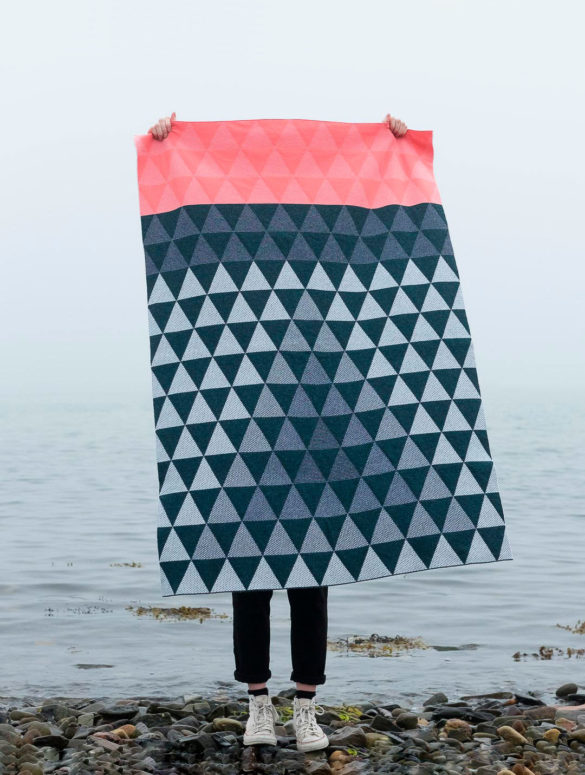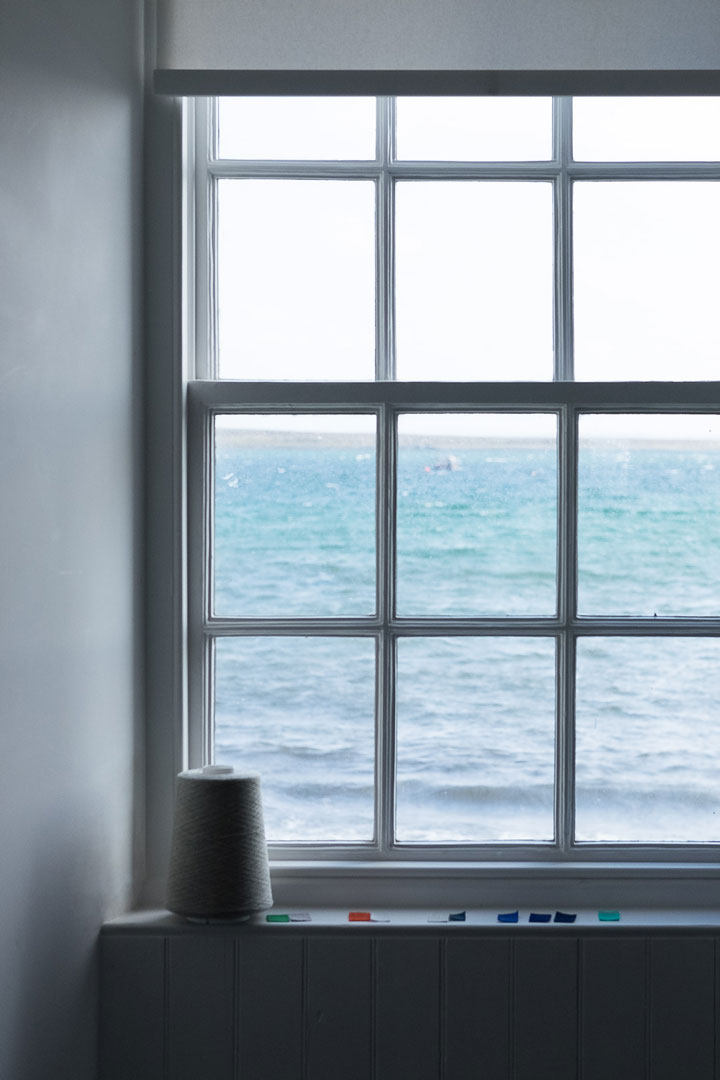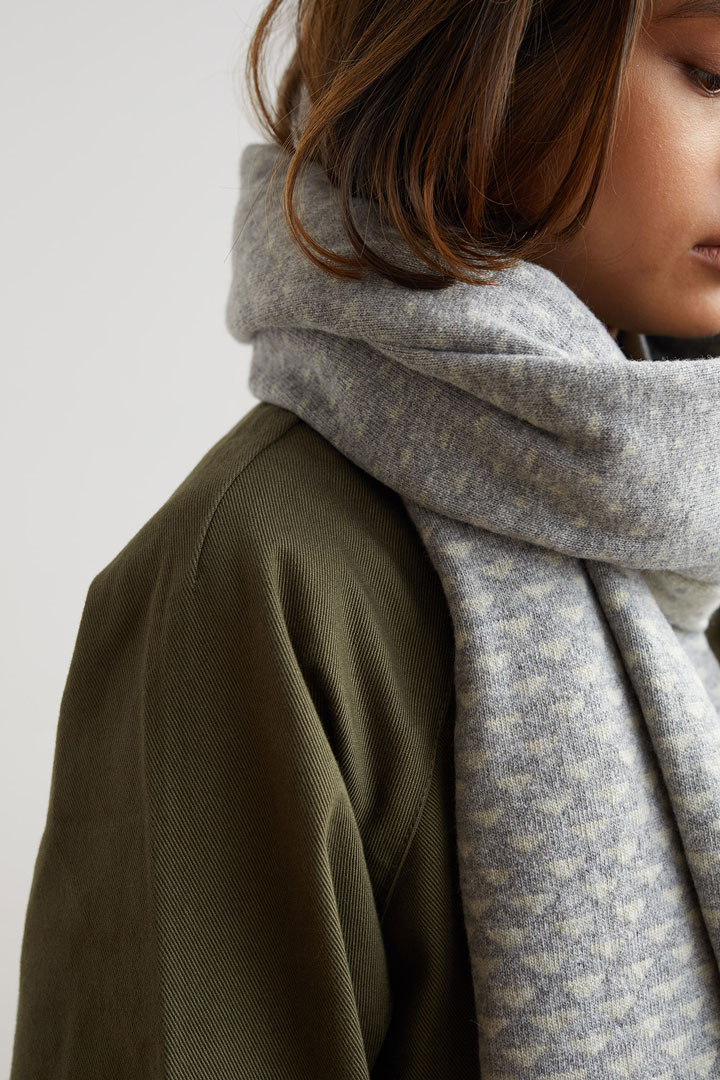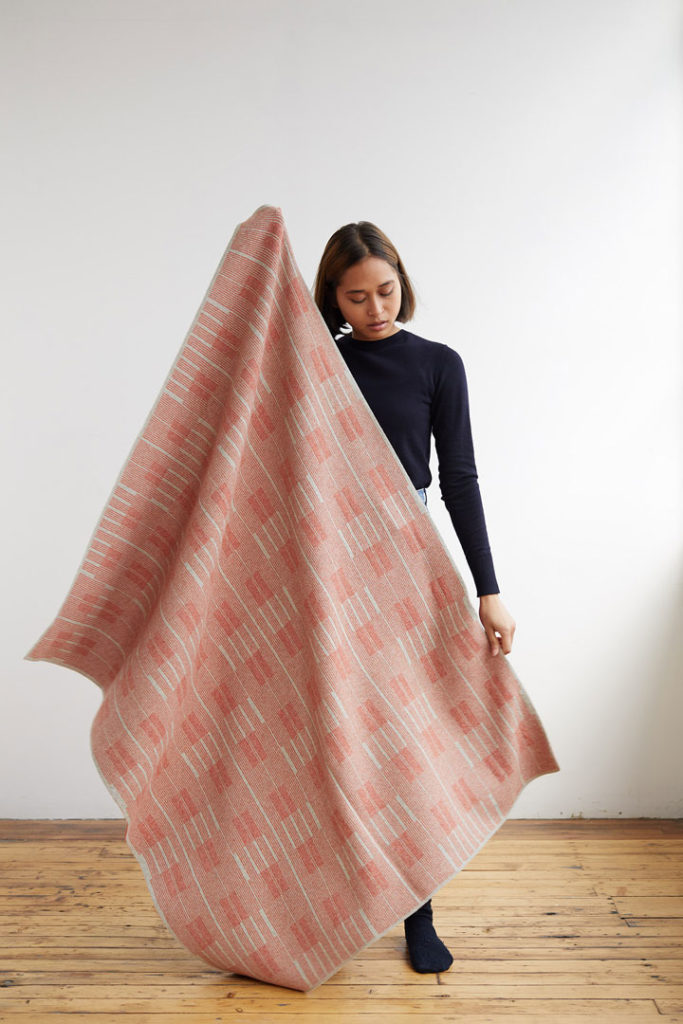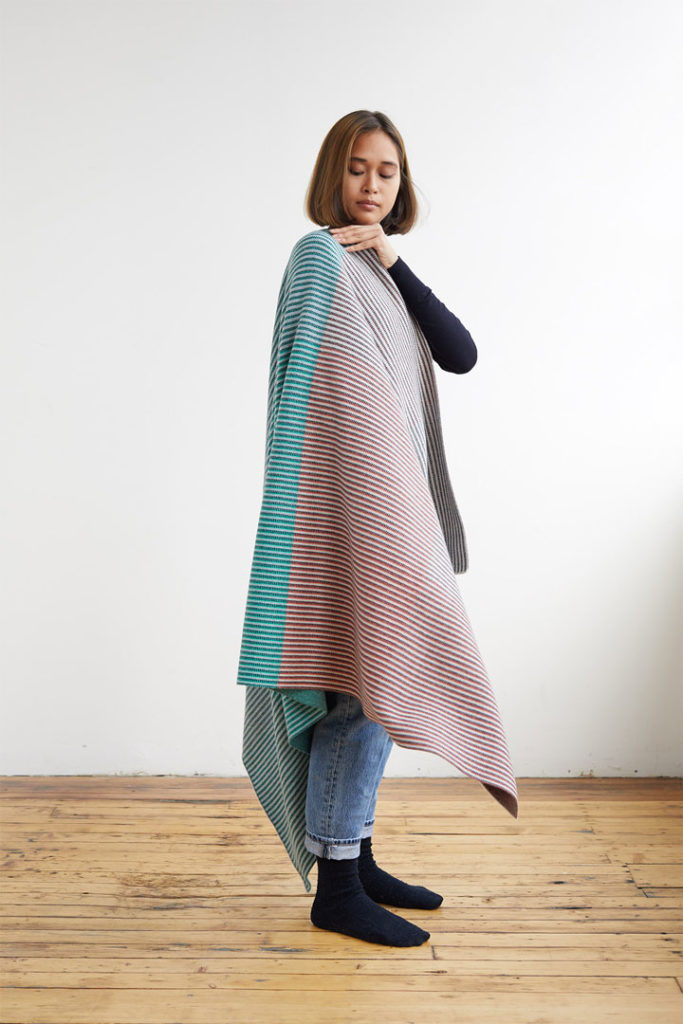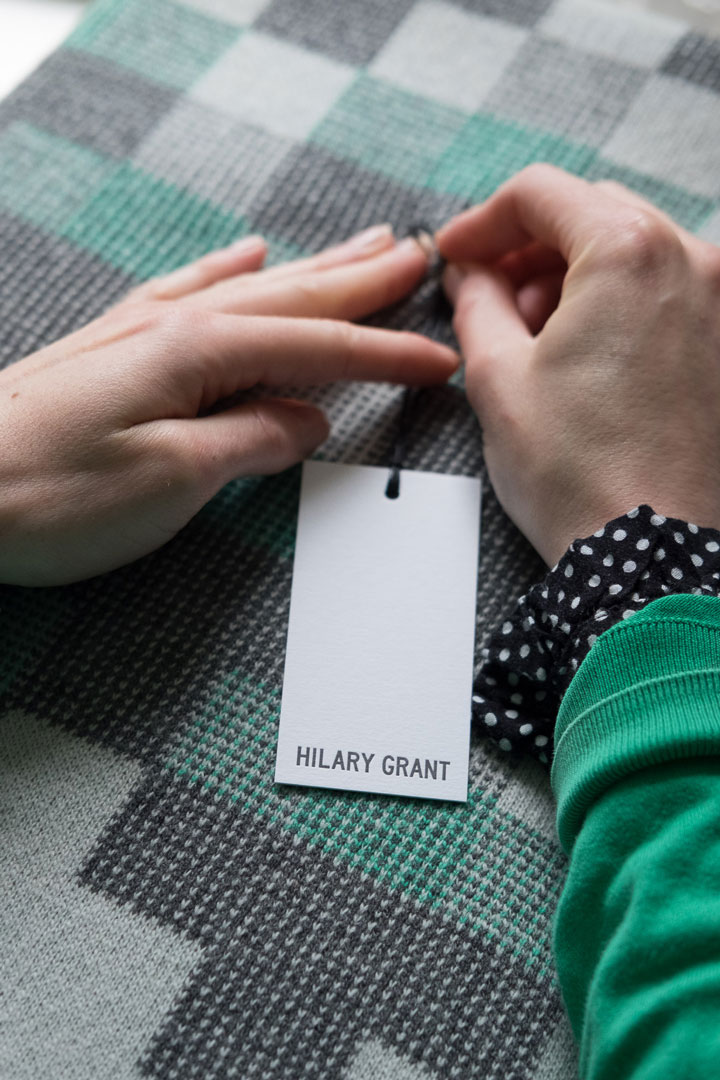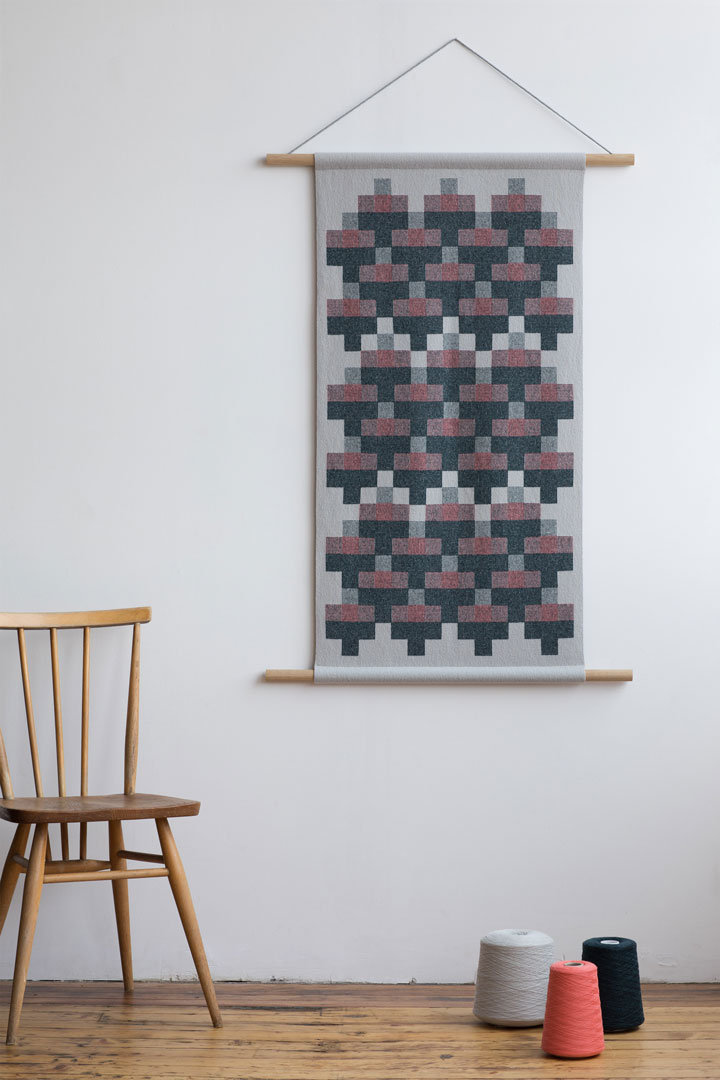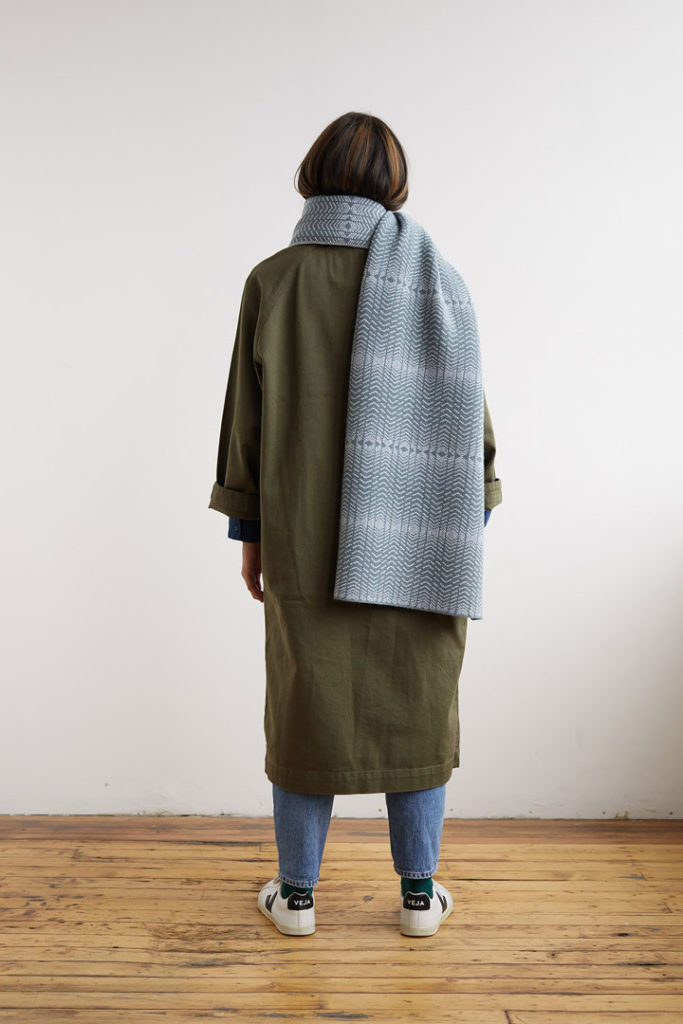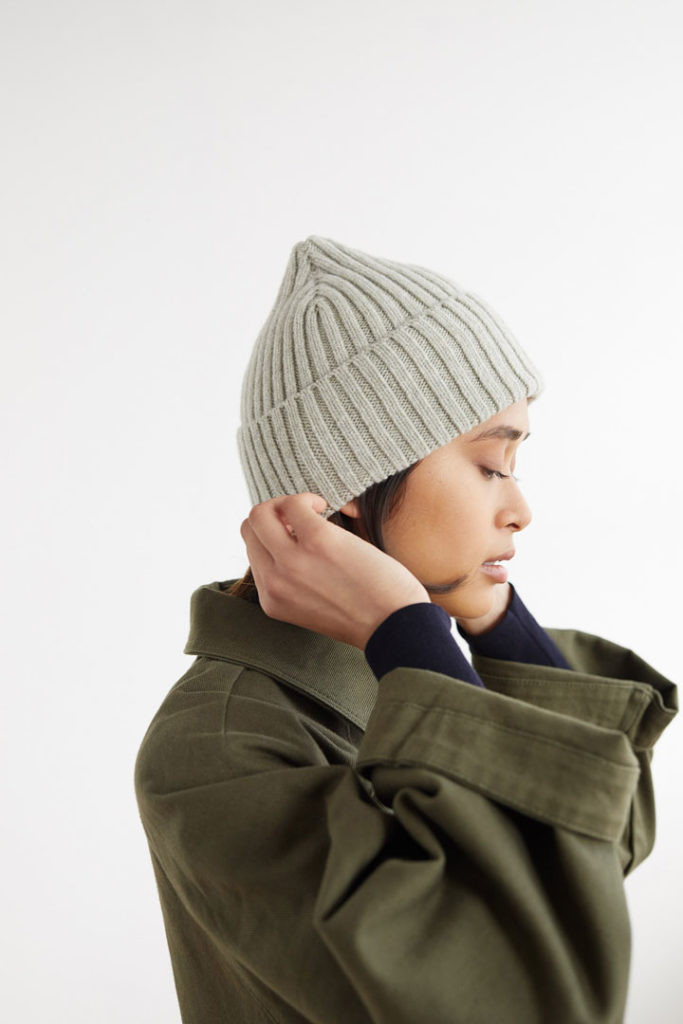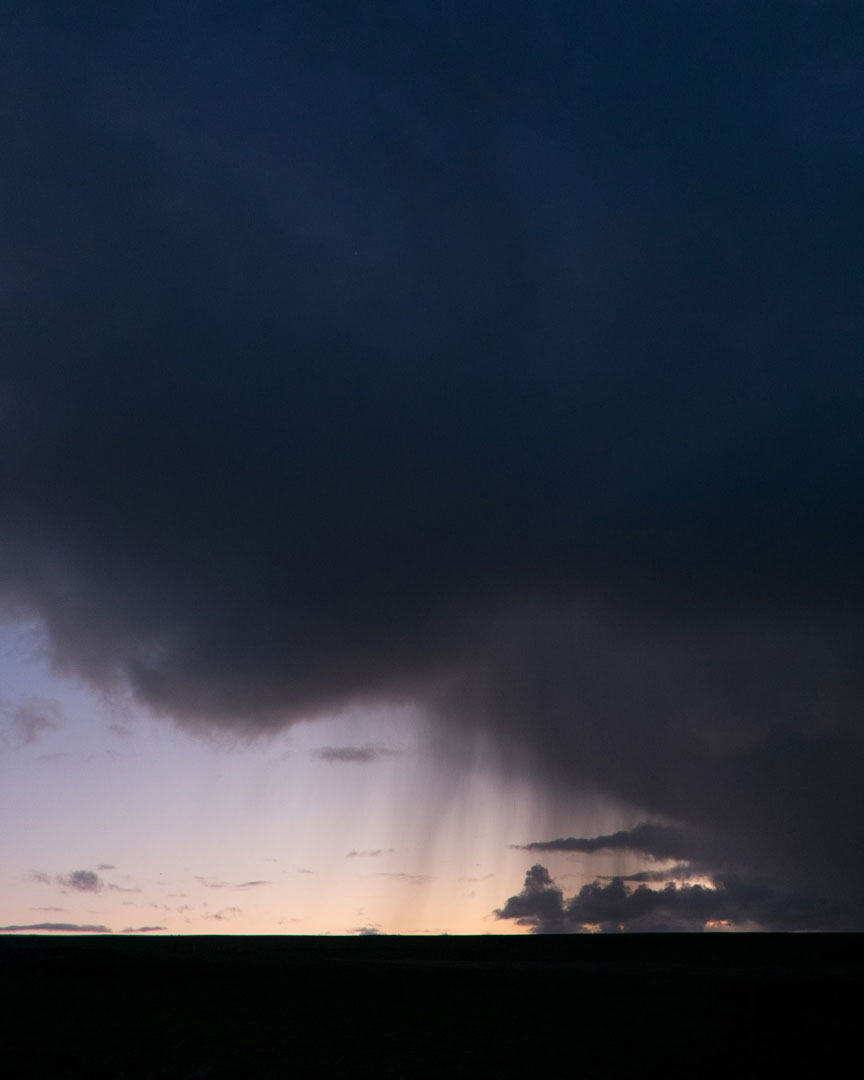An over 2,500Km distance videochat between Hilary (Orkney) and Igor (Madrid).
Then images you’ll see in this article have been taken by Elliott Hatherley (studio shots) and Hilary Grant.
58º north and 3º west, these are the approximate latitude and longitude of Hilary Grant‘s location when we had the conversation that follows.
Although Hilary is originally from the west coast of Scotland, she moved to Orkney – an archipelago off the northern coast of the country – around 8 years ago. It’s on this remote island where Hilary and her partner, Rob Harvey, run their textile design studio and get inspiration to create unique knitted pieces that blend heritage and tradition with aesthetics influenced by different art and design movements.
I had the chance to see how these pieces are manufactured in person when I lived in Edinburgh and accompanied Hilary on a trip to the Scottish Borders in 2016. At that time, Hilary and Rob had created a blanket as part of Local Heroes, a design commission and exhibition exploring modern Scottish design.
With current movement and travel restrictions, it couldn’t be a better moment to catch up on this topic and talk about local identity and heritage, the influence of global trends and how a product can transport you to the place where it was originally made.
Igor Termenón
Hilary Grant
I want to start talking about how fashion has made Fair Isle jumpers popular, but I was wondering if there’s a similar knitting tradition in Orkney.
Fair Isle1 is a really small island which is kind of equidistant between Orkney and mainland Shetland. Since Victorian times, I think, Shetland knitwear has had this really strong identity and the work of its knitters was even shown at the Great Exhibition in London in 1851.
Orkney2 is known more for silversmithing and ceramics traditionally, and there’s also a history of weaving. It was once marketed as a Scotland product — around the early 1900s — but the reality is that textiles are not just a national identity. Sometimes they can come from a really small place and be quite unique to that location, so that’s kind of the history with textiles and Orkney.
I’ve always wanted to create something that feels new, but you’re always influenced by other historical elements.
Growing up in Scotland, surrounded by a very strong knitting tradition and heritage, I’d like to know more about the references that made you start your own label.
Traditional textiles and also knitwear from Fair Isle have been a huge influence in my work. I think there’s a language in the type of pattern that has a very familiar rhythm, in the way of building up and developing colours, so that’s something that I’ve been really inspired by. I’ve always wanted to create something that feels new, but you’re always influenced by other historical elements.
I used to be really interested in traditional craft aspects and over the past 5 years or so, especially because of Rob’s background in architecture and his knowledge, I also started to become more interested in mid-century textiles and the Bauhaus, and the kind of nature of domestic textiles that cross over between design, craft and fine art.
I remember our trip to your mill in the Scottish Borders with Local Heroes in the summer of 2016. At that time, Stacey Hunter was starting this project to give visibility to modern Scottish design abroad and, also, in Scotland.
I think it’s really important to show your culture and design, not just through traditions that people are familiar and comfortable with, but showing what is being created in the present time and how different it can be to what is expected!
Sometimes it doesn’t always present itself in a certain aesthetic, but I think Stacey did an amazing job with Local Heroes3, finding the common threads between all the different designers. It takes someone else and their eye, and a really sensitive visual sensibility to do that.
Thinking about Denmark or Finland, they’re known for both craft and contemporary design – and the two countries have been promoting these two industries as part of their cultural identity since the mid-century. Compared to them, it’s still relatively early days in Scotland.
How to wrap a blanket or how to keep warm with these designs 100% made in Scotland
This was very necessary because you hear all the time about Scotland being a great place for high-quality knitwear manufacturing, but you don’t usually think about it as a country known for its design. For example, most Scottish designers end up moving to London to establish their brands there.
I think you’re totally right. People come from Scotland and then go to London, which was thought of as the only route for most creative and arts-based industries. Your work gets caught up in this whole global idea of creative work and it’s just seen in a global context, and not seen in relation to a particular place. That’s why you have certain fashion houses visiting Shetland looking for ideas for their AW collections.
Thinking about Denmark or Finland, they’re known for both craft and contemporary design – and the two countries have been promoting these two industries as part of their cultural identity since the mid-century. Compared to them, it’s still relatively early days in Scotland.
Would you say your design is Scottish?
This is such a hard question to answer because I think we could spend a lot of time talking about what something means as being Scottish, or of a national identity.
I think our work could definitely be classified as Scottish design – Scottish in the way that it’s made by someone living in Scotland and, as a result, makes a small contribution towards an idea of what Scottish Design is.
This is the kind of thing we try to do with our textiles: maintaining the idea of local and cultural influence whilst making it appealing for a global audience.
Going back to that idea of globalisation and how you can be so easily influenced by all the different trends that are showcased online; can someone’s work still retain elements of that visual identity from the place where it was created?
I think you can definitely achieve both. This is the kind of thing we try to do with our textiles: maintaining the idea of local and cultural influence whilst making it appealing for a global audience.
Our work is a result of a combination of both hyper-local influences from traditional folk-crafts, techniques and domestic textiles, and more influences from internationalist art and design movements and ideals like the Bauhaus and modernism, where craft and industrial processes are combined.
I think what you do is definitely a great example of having those two elements well balanced. Now that we’re talking about that global audience, I’m interested in finding out more about your customers and where they’re based.
We’ve had lots of customers from Japan, but we find ourselves selling to stores and individual customers in lots of different countries.
For example, in the last couple of years, we’ve sold more in the USA to some museums like the Chicago Museum of Contemporary Art. And last winter, we had lots of online orders coming from the US as a result.
It’s amazing that all these cultural institutions and shops want to showcase products from all over the world. I think it is a really interesting time as there are more people consuming things and buying clothes with the “shop local but global” mindset. So it’s equally about supporting the small, authentic producers you can find locally, but also small businesses that are doing really interesting, different half way across the globe.
I think it is a really interesting time as there are more people consuming things and buying clothes with the “shop local but global” mindset.
Focusing on Japan, there’s this connection between Japanese customers and things made in Scotland. What do you think the reason is?
In Japan, I think the average retail consumer has a really sophisticated, attuned and advanced taste – you can buy anything you want in Tokyo. So it’s not just about a one-dimensional trend, but a whole holistic aesthetic wrapped up in fashion, food and lifestyle.
Maybe also because traditional Scottish textiles are so wrapped up in an entire way of life, history and traditions; which is perhaps an important part of Japanese culture?
I don’t think I can completely answer your question as I’m not an expert in Japanese culture and retail but, from our personal experience in business supplying department stores, we tend to find that our collections that have more traditional leanings and reference points tend to do much better in the Japanese market than our more original, design-led pieces which are more popular in Europe and the US.
I recently read a brilliant piece in High Snobiety with Mark Hogarth from Harris Tweed Hebrides about why it’s thought traditional Scottish textiles are so popular in Japan, and it’s more to do with a combination of factors such as that wool isn’t produced widely in Japan and the adoption of the preppy American style in Japan in the 60s and 70s, which included a lot of tartan. It’s so fascinating as it shows that culture and fashion are so linked throughout history between countries and no culture has ever existed and thrived in it’s own closed-off bubble.
Instagram is a a really useful way to showcase your brand, but it’s also a really great way to figure out what it is through visual imagery and developing your own unique aesthetic.
Knitted from super soft lambswool in the Scottish Borders, here are 2 of the key accessories from Hilary Grant’s collection
Thanks in part to social media, anyone in the world can have access to your brand. I think it’s really interesting the way you use Instagram to show everything that is behind your brand and, particularly, how you feature Orkney in your content.
Instagram is a a really useful way to showcase your brand, but it’s also a really great way to figure out what it is through visual imagery and developing your own unique aesthetic. When we started, we didn’t have this set-in-stone idea of what our brand values were and all those things that are usually predetermined before you even have a product.
We wanted the product to lead how the brand develops, which is far more interesting to me. We take inspiration from our surroundings, and try to capture and showcase that4 in a modern way that reflects on our approach to design. For example, an instant when the sky changes can influence a yarn colour, and the product you end up making can remind you of that moment.
I guess most of your customers live in cities, and being able to see something that it’s so different and far away from what they experience in their daily lives makes your products even more appealing.
I think people like the idea of products that feel local and can relate to. Sometimes, when you visit a new place or city and find all these amazing things being made there – whether it is fashion, design or food even – they all sum up what the place means and you want to take them home in order to take that feeling with you.
I think that’s what I want people to feel if they come here or to Scotland and buy one of my products. I guess that’s also connected to Stacey’s idea for Local Heroes: a modern ‘souvenir’ that you can take home and it reminds you of a place, and the uniqueness of it.
A lot of the brands I find really like, they bring a sense of the place into the product, and how they show you. Like a company I saw in Finland called Lapuan Kankurit a Finnish company that makes home textiles and scarves. You feel like you are enjoying a little bit of the Finnish way of living when you use their textiles. Or the same idea when you wear a top that’s come from an independent designer based in California.
I think people like the idea of products that feel local and can relate to.
Definitely, it happens to me with Antwerp. I get this nice feeling when I’m walking around its streets and I’m able to identify or understand the inspirations of some of my favourite designers from there.
You can see everyday parts that a designer or a creative person would see, and you can understand their sensibility to colour and their reference points.
You’re exploring a place but you’re also exploring its culture — I actually love that idea.
1. Although it’s not exactly clear where Fair Isle patterns originated from, generations of knitters have reinterpreted them. Traditional patterns have a limited palette of usually 5 colours and only 2 colours per row.
2. The Orkney archipelago comprises over 70 islands and skerries, but only 20 of them are permantently inhabited.
3. Founded by design curator and exhibition maker Stacey Hunter, Local Heroes puts design from Scotland on an international stage, presenting and promoting Scottish products and industries to the public, with a focus on high quality design.
4. Some of the latest inspiration on Hilary Grant’s Instagram include seabirds swooping out over the water, reflections on the water after a week of wind and gales, and Snowdrops showing a brave face at end of the garden.


